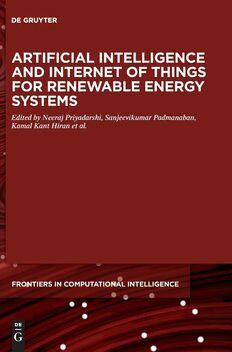Table Of ContentNeerajPriyadarshi,SanjeevikumarPadmanaban,KamalKantHiran,
JensBoHolm-Nielson,RameshC.Bansal(Eds.)
ArtificialIntelligenceandInternetofThingsforRenewableEnergySystems
De Gruyter Frontiers in
Computational Intelligence
Edited by
Siddhartha Bhattacharyya
Volume 12
Artificial Intelligence
and Internet of Things
for Renewable Energy
Systems
Edited by
Neeraj Priyadarshi, Sanjeevikumar Padmanaban,
Kamal Kant Hiran, Jens Bo Holm-Nielson,
Ramesh C. Bansal
Editors
Dr.NeerajPriyadarshi Dr.KamalKantHiran
CTiFGlobalCapsule DepartmentofComputerScienceEngineering
DepartmentofBusinessDevelopmentand SirPadampatSinghaniaUniversity
Technology Udaipur-ChittorgarhRd
AarhusUniversity Bhatewar313601
Herning Rajasthan
Denmark India
CommunicationandNetworkingDepartment [email protected]
RenewableEnergyLaboratory
PrinceSultanUniversity Dr.JensBoHolm-Nielson
Riyadh DepartmentofEnergyTechnology
SaudiArabia AalborgUniversity
[email protected] 6700Esbjerg
Denmark
Dr.SanjeevikumarPadmanaban [email protected]
CTiFGlobalCapsule
DepartmentofBusinessDevelopmentand Dr.RameshC.Bansal
Technology DepartmentofElectricalandComputer
AarhusUniversity Engineering
Herning UniversityofSharjah
Denmark UniversityCityRd
CommunicationandNetworkingDepartment UniversityCity
RenewableEnergyLaboratory UnitedArabEmirates
PrinceSultanUniversity [email protected]
Riyadh
SaudiArabia
[email protected]
ISBN978-3-11-071379-4
e-ISBN(PDF)978-3-11-071404-3
e-ISBN(EPUB)978-3-11-071415-9
ISSN2512-8868
LibraryofCongressControlNumber:2021945435
BibliographicinformationpublishedbytheDeutscheNationalbibliothek
TheDeutscheNationalbibliothekliststhispublicationintheDeutscheNationalbibliografie;
detailedbibliographicdataareavailableontheInternetathttp://dnb.dnb.de.
©2022WalterdeGruyterGmbH,Berlin/Boston
Coverimage:shulz/E+/gettyimages
Typesetting:IntegraSoftwareServicesPvt.Ltd.
Printingandbinding:CPIbooksGmbH,Leck
www.degruyter.com
Preface
Thisbook presentsartificialintelligenceand machinelearning framework for renew-
ableenergysystems.Themachinelearningmodelswithrespecttosolarenergystorage
systempredictionsareanalyzedinChapter1.ThefourthcomponentoftheInternetof
things(IoT)systemistheuserinterface;thishelpstheuserstocontrolIoT.Chapter2
highlights the study and implementation of various types of fuzzy structures using
rule-basedinterfacesforsteady-stateandtransientanalysis.Chapter3providesasur-
veyoftherole,impact,andchallenges,and recommended solutionsof IoTforsmart
buildings.Chapter4presentsacomprehensivedesignofalow-costsmartsingle-phase
energy metermonitoring system. Chapter 5 explains the IoT-basedsmart grid. Chap-
ter6presentsmaximumpowerpointtrackingcontrolusingparticleswarmoptimiza-
tionalgorithmforphotovoltaic(PV) panelaffectedbypartialshadingduetoshadow
casting.PartialshadingcastedonaPVpanelwillproducemultiplepeaks’powerchar-
acteristic curve, thustracking the global peak becomesa challengeespecially under
dynamicchangingpartialshadingcondition.Chapter7discussesawirelesssystemfor
monitoringandcontrollingofanelectricalsubstationusingNodeMCU(Wi-Fimodule),
Arduino Uno (microcontroller), ThingSpeak server, and Blynk. The different pa-
rameters of the substation such as current, voltage, power factor, frequency, and
temperature are monitored using various sensors and electronic components.
Smart grid–based big data analytics using machine learning and artificial intelli-
gence has been discussed in Chapter 8. Chapter 9 presents the IoT-based intelli-
gentsolarenergy-harvestingtechniquewithimprovedefficiency.
https://doi.org/10.1515/9783110714043-202
Contents
Preface V
AbinayaInbamani,PrabhaUmapathy,KathirvelChinnasamy,
VeerapandiyanVeerasamy,S.VenkateshKumar
1 ArtificialintelligenceandInternetofthingsforrenewableenergy
systems 1
BibhuPrasadGanthia,SubratKumarBarik,ByamakeshNayak
2 PowercontrolofmodifiedtypeIIIDFIG-basedwindturbinesystemusing
four-modetypeIfuzzylogiccontroller 41
B.Gunapriya,A.Singaravelan,M.Karthik,M.Mahesh,K.Sudhapriya
3 AnIoT-basedapproachforefficienthomeautomation 91
ZhangRuiChoo,HungyangLeong,RodneyH.G.Tan
4 DesignandimplementationofIoT-enabledsmartsingle-phaseenergy
metermonitoringsystem 123
MonikaYadav,AmritanshMehrotra,DevenderKumarSaini
5 Internetofthings(IoT)-basedsmartgrids 165
JiaShunKoh,RodneyH.G.Tan,WeiHongLim
6 Maximumpowerpointtrackingcontrolunderpartialshadingconditions
usingparticleswarmoptimizationalgorithm 185
VarshaSingh,SimranBajaj,ShreyashGanvir,SwapnilSahu,MahendraGavel
7 WirelessmonitoringofsubstationusingIoT 215
SubinKoshy,S.Rahul,R.Sunitha,ElizabethP.Cheriyan
8 Smartgrid–basedbigdataanalyticsusingmachinelearning
andartificialintelligence:asurvey 241
EmdadulHoque,DipKumarSaha,DibakarRakshit
9 IoT-basedintelligentsolarenergy-harvestingtechniquewithimproved
efficiency 279
Editor’sBriefBiographies 303
Index 307
Abinaya Inbamani,Prabha Umapathy,KathirvelChinnasamy,
Veerapandiyan Veerasamy,S.Venkatesh Kumar
1 Artificial intelligence and Internet of things
for renewable energy systems
Abstract: The sustainability incredibly insists in having innovations in renewable
energy. To obtain an unsullied and a well-grounded environment, innovations in
the present mechanisms have to be uplifted ensuring a predictive framework and
anenormousoutcome canbeexpected.The goalneedstobemettoestablishnew
research concepts and to move on the energy requirements in optimization of the
existingmachinelearning(ML)framework.Withthelotmorerenewableenergyex-
istinginnature,thetwomostvariableandcommonlyusedrenewableenergiesare
solarandwind.Itsconsarenonuniformityofpoweranditsdependencyonexternal
environmental factors. Due to this, sole dependence on renewable energy is not
possible,andhenceconventionalpowergridisalsotobeconsideredwhenanysort
of predictive analysis needs to be done. Hence, more concentration is to be made
onforecastingofrenewableenergyandonsmartgridsensuringcontinuousequilib-
rium and balance within renewable energy and conventional grid. The electricity
demandandsupplyofpowercanbepredictedusingMLalgorithmsensuringbetter
savings with operational costs. The two-way electricity and information flow will
provesmartgridinfutureensuringcontinuousmonitoringofthenetworkbringing
more requirements for ML framework. The early warning systems incorporated by
Germany symbolize a very good example of how ML algorithms analyze the real-
timedatafromvariousrenewableenergysourcestoanalyzethetotalamountofenergy
requirementofthecountry.GoogleinventiononDeepMindprovesthattheenergyeffi-
ciencyis3.5timesmorecomparedtotheenergydemandsofthelast5years.Theinno-
vations on intelligent home energy management systems prove promising energy
usagewithMLinrealtime.Theconsumerorthecustomerbehaviorcanbepredicted
easilywithintelligenttechniquesalongwithvariousotherfeatureslikeweatherorcli-
mate modeling ensuring a complete and interoperable frameworkthatsuits the con-
ventional grids. Artificial intelligence helps in sustainability of the grid with more
focusondemandresponse.Theenergymanagementandoperationcostmanagement
insmartgridisapromisingfeatureincorporatingMLalgorithmsinrenewableenergy.
AbinayaInbamani,DepartmentofElectricalandElectronicsEngineering,SriRamakrishna
EngineeringCollege,Coimbatore,e-mail:[email protected]
PrabhaUmapathy,KathirvelChinnasamy,S.VenkateshKumar,DepartmentofElectrical
andElectronicsEngineering,SriRamakrishnaEngineeringCollege,Coimbatore
VeerapandiyanVeerasamy,AdvancedLightning,PowerandEnergyResearch(ALPER),Department
ofElectricalandElectronicsEngineering,FacultyofEngineering,UniversityPutraMalaysia
(UPM),UPMSerdang,Selangor43400,Malaysia
https://doi.org/10.1515/9783110714043-001
2 AbinayaInbamanietal.
Theoptimizationonmanagingtheassetalongwithitsmaintenance ensuresefficient
managementofpower.Thelargeamountofdatacollectedbringsdataminingandpre-
diction,therebyenablingmoreanalyticsondata.Toestablishsuchakindofplatform,
varioustransfermodelsforsolarandwindneedtobeappliedalongwithirradianceto
powermodels incorporating blending of information along with its categorization in
MLalgorithms.FeatureselectionmethodsalongwiththediversifiedalgorithmsinML
for diversified applications ensurecontinuous upgradation in framework ratherthan
integratedapproach.
Keywords:renewableenergy,artificialintelligence,machinelearningframework
1.1 Solar energy storage systems and grid-
connected PV systems
To consider being an infinite feature, renewable energy is significantly acquired
fromnaturalresources.Sincethenaturalresourcesarecapableofprovidingrenew-
ableenergyendlessly,itcanbeutilizedinfinitely.Regardlessofanyvulnerablepol-
lutant’semission,therenewableenergycanbeharnessed,whichareconsideredas
a significant feature. Renewable energy generation sources are very essential for
providing green energy to remote rural areas as well as urban areas. Some of the
renewableenergyresourcesaresolarpower,windpower,biomass,oceanwaveen-
ergy, geothermal energy, hydroelectric power, and tidal power. Renewable energy
sourceisoftentermedasalternativeenergyresources,sinceitisconsideredbeinga
replacementtofossilfuelsandnuclearpower.Thereareafewaspectsofrenewable
energyasfollows:
– Existenceofrenewableenergyisperpetual,anditisinfiniteintheenvironment.
– Alwaysabletobeharnessed,unlimitedly.
– Knownbeingacleanalternativeenergythanfossilfuels.
– Canbereplenishedconsistently.
1.1.1 Overview of solarenergy system
Solar energy is one amid massively available renewable energy source and best
cleanest energy source. Solar energy’s key source is sun’s radiation obtained from
the Sun. Solar-powered electrical generation depends on photovoltaic (PV) and
heat engines. The solar energy usage is always anticipated to proliferation around
theworldintheforthcomingcenturies.Mainly,middleandlowlatitudes mightbe
thechiefenergysourcewhichimproveseconomyafterglobalandlocalcrises.Solar
energy is pollution free and comparatively no greenhouse gases are emitted. Solar
technologies are generally characterized by two methods: (i) passive solar and (ii)

